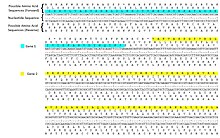How Does Open Reading Frame Help to Assign Function

Analogy of possible reading frames:
AGG·TGA·CAC·CGC·AAG·CCT·TAT·ATT·AGC
A ·GGT·GAC·ACC·GCA·AGC·CTT·ATA·TTA ·GC
AG ·GTG·ACA·CCG·CAA·GCC·TTA·TAT·TAG· C
In molecular biology, a reading frame is a fashion of dividing the sequence of nucleotides in a nucleic acrid (DNA or RNA) molecule into a set up of sequent, not-overlapping triplets. Where these triplets equate to amino acids or terminate signals during translation, they are called codons.
A single strand of a nucleic acrid molecule has a phosphoryl end, called the 5′-finish, and a hydroxyl or 3′-finish. These ascertain the v′→3′ direction. There are three reading frames that can be read in this 5′→3′ management, each kickoff from a different nucleotide in a triplet. In a double stranded nucleic acid, an additional three reading frames may be read from the other, complementary strand in the 5′→3′ direction along this strand. As the ii strands of a double-stranded nucleic acid molecule are antiparallel, the five′→3′ direction on the second strand corresponds to the 3′→5′ direction along the outset strand.[i] [2]
In full general, at the most, one reading frame in a given department of a nucleic acid, is biologically relevant (open reading frame). Some viral transcripts can be translated using multiple, overlapping reading frames. In that location is one known case of overlapping reading frames in mammalian mitochondrial DNA: coding portions of genes for two subunits of ATPase overlap.

An example of a vi-frame translation
Genetic lawmaking [edit]
Deoxyribonucleic acid encodes protein sequence by a series of 3-nucleotide codons. Whatever given sequence of DNA can therefore exist read in six different ways: 3 reading frames in ane direction (starting at unlike nucleotides) and three in the opposite management. During transcription, the RNA polymerase read the template Deoxyribonucleic acid strand in the 3′→5′ management, but the mRNA is formed in the 5′ to 3′ management.[three] The mRNA is single-stranded and therefore only contains iii possible reading frames, of which merely i is translated. The codons of the mRNA reading frame are translated in the v′→iii′ direction into amino acids by a ribosome to produce a polypeptide chain.
Open reading frame [edit]
An open reading frame (ORF) is a reading frame that has the potential to exist transcribed into RNA and translated into poly peptide. It requires a continuous sequence of DNA from a start codon, through a subsequent region which ordinarily has a length that is a multiple of 3 nucleotides, to a stop codon in the same reading frame.[4]
When a putative amino acid sequence resulting from the translation of an ORF remained unknown in mitochondrial and chloroplast genomes, the corresponding open reading frame was called an unidentified reading frame (URF). For instance, the MT-ATP8 gene was beginning described as URF A6L when the complete human mitochondrial genome was sequenced.[5]
Multiple reading frames [edit]

The two reading frames used by the human mitochondrial genes MT-ATP8 and MT-ATP6.
The usage of multiple reading frames leads to the possibility of overlapping genes; in that location may be many of these in viral, prokaryote, and mitochondrial genomes.[half dozen] Some viruses, due east.thou. hepatitis B virus and BYDV, employ several overlapping genes in dissimilar reading frames.
In rare cases, a ribosome may shift from i frame to another during translation of an mRNA (translational frameshift). This causes the kickoff function of the mRNA to be translated in 1 reading frame, and the latter part to exist translated in a dissimilar reading frame. This is distinct from a frameshift mutation, as the nucleotide sequence (Dna or RNA) is non contradistinct—only the frame in which it is read.
See also [edit]
- Genetic code
- Directionality (molecular biological science)
- Sense (molecular biological science)
References [edit]
- ^ Rainey S, Repka J. "Quantitative sequence and open reading frame analysis based on codon bias" (PDF). Systemics, Cybernetics and Informatics. iv (1): 65–72.
- ^ Badger JH, Olsen GJ (April 1999). "CRITICA: Coding Region Identification Tool Invoking Comparative Analysis". Mol Biol Evol. 16 (four): 512–24. doi:10.1093/oxfordjournals.molbev.a026133. PMID 10331277.
- ^ Lodish (2007). Molecular Cell Biology (6th ed.). W. H. Freeman. p. 121. ISBN978-1429203142.
- ^ Benjamin C. Pierce (2012). Genetics: a conceptual arroyo. Westward. H. Freeman. ISBN9781429232500.
- ^ Anderson S, Bankier AT, Barrell BG, de Bruijn MH, Coulson AR, Drouin J, Eperon IC, Nierlich DP, Roe BA, Sanger F, Schreier PH, Smith AJ, Staden R, Young IG (April 1981). "Sequence and organization of the human being mitochondrial genome". Nature. 290 (5806): 457–65. Bibcode:1981Natur.290..457A. doi:10.1038/290457a0. PMID 7219534.
- ^ Johnson Z, Chisholm S (2004). "Properties of overlapping genes are conserved across microbial genomes". Genome Res. 14 (11): 2268–72. doi:10.1101/gr.2433104. PMC525685. PMID 15520290.
Source: https://en.wikipedia.org/wiki/Reading_frame
Posting Komentar untuk "How Does Open Reading Frame Help to Assign Function"